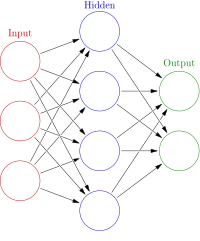
Photo from wikipedia
There are many conventional methods that have been applied in transient electromagnetic (TEM) random noise suppression such as stacking-averaging, but when the TEM system works in urban areas with strong… Click to show full abstract
There are many conventional methods that have been applied in transient electromagnetic (TEM) random noise suppression such as stacking-averaging, but when the TEM system works in urban areas with strong noise, these methods are not effective due to the extremely low signal-to-noise ratio (SNR). We propose a new method combining the minimum noise fraction (MNF) algorithm and deep learning. The MNF and the deep neural network (DNN) are used to extract the complex features of signals from the noisy signal data. After using MNF to improve the SNR of TEM to a certain extent, the convolutional neural network (CNN) and gated recurrent unit (GRU) were used to extract spatial and temporal features of the signal, and the training was guided by the double loss function. To verify the effectiveness of the method, we have done quantitative experiments on synthetic noise and field noise, respectively. The experimental results show that our method achieves the most advanced performance.
Journal Title: IEEE Geoscience and Remote Sensing Letters
Year Published: 2022
Link to full text (if available)
Share on Social Media: Sign Up to like & get
recommendations!